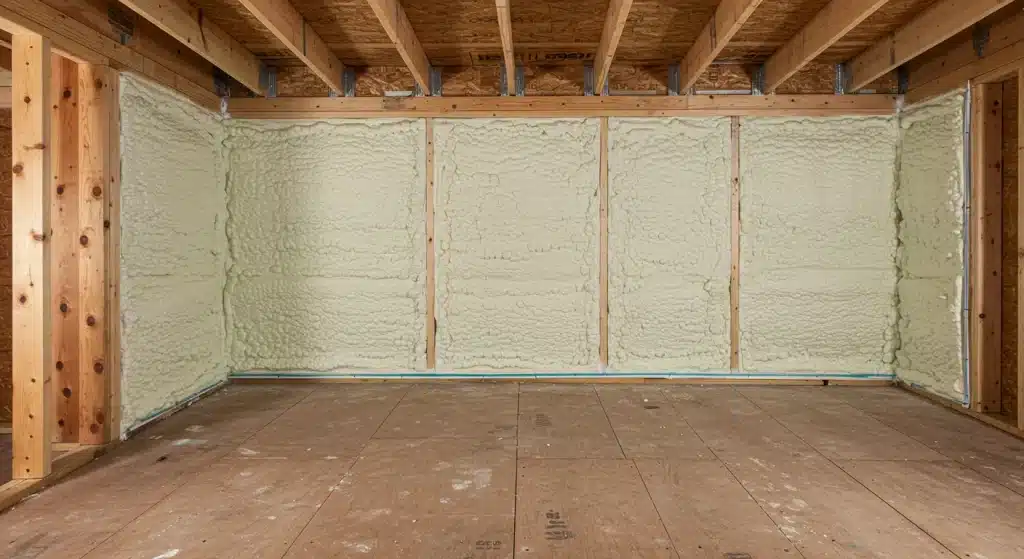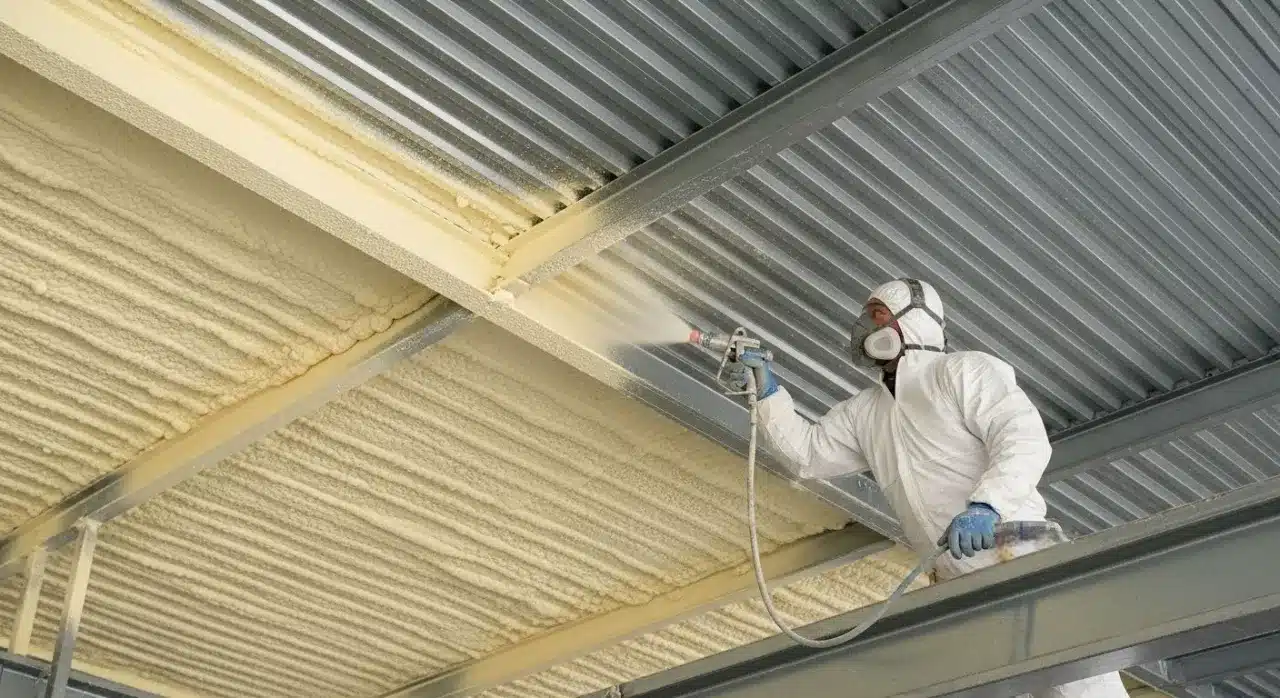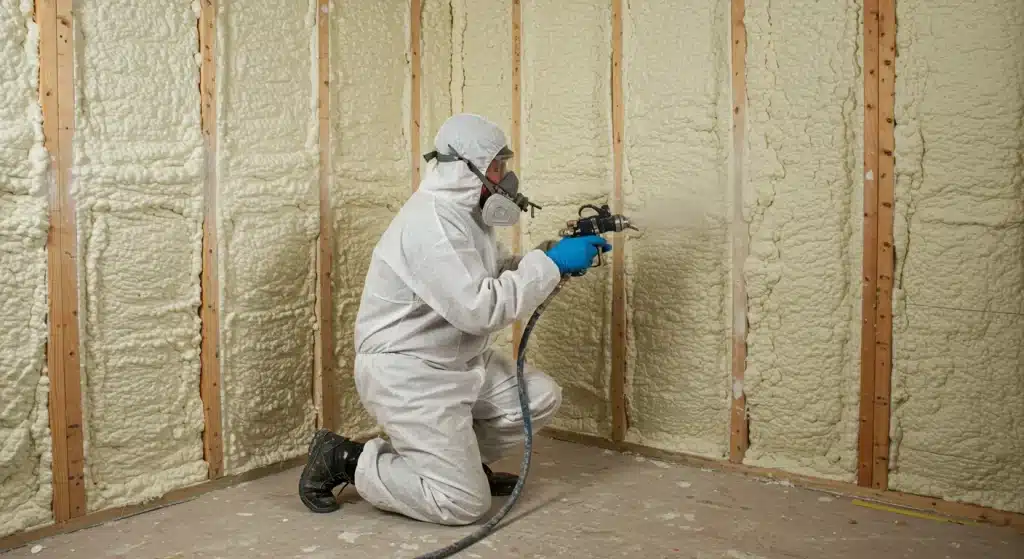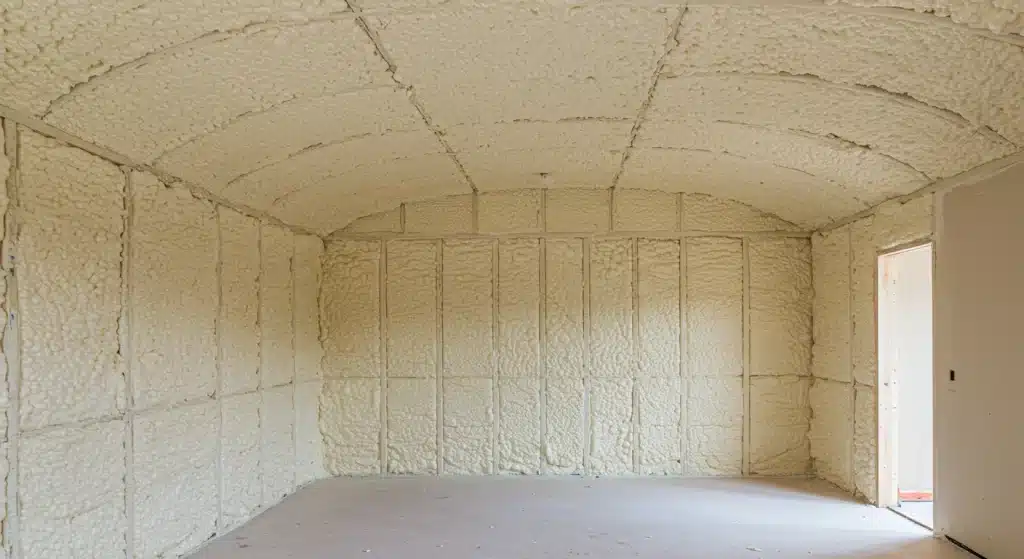Spray foam insulation stops ice dams by creating a complete air and thermal barrier between the home’s heated living space and the cold underside of the roof deck. This prevents warm, moist air from escaping into the attic, which is the primary cause of snow melting on the roof. When the roof surface remains at or below freezing temperatures, the snow on top doesn’t melt, and the cycle of thawing and refreezing that forms ice dams at the eaves is completely avoided.
By eliminating this heat transfer, spray foam directly addresses the root cause of the problem, not just the symptoms. This article explains the mechanics of how ice dams form and details the specific properties of spray foam that make it an effective, long-term solution. The information here is based on years of direct experience in resolving insulation-related issues for homeowners, offering a clear look at how to protect a property from winter roof damage.
Understanding How Ice Dams Form
Ice dams are ridges of ice that form at the edge of a roof and prevent melting snow from draining off. The water that backs up behind the dam can leak into a home and cause damage to walls, ceilings, insulation, and other areas. This problem begins in the attic. The University of Minnesota Extension explains that the entire process is driven by heat escaping from the house into the attic space.
When a home’s heated air leaks into a poorly insulated or ventilated attic, it warms the underside of the roof deck. This heat conducts through the roofing materials and melts the snow on the roof from the bottom up, even when the outside air temperature is well below freezing. The melted snow, now water, runs down the roof until it reaches the cold eaves and gutters, which are not warmed by the attic’s heat. Here, the water refreezes, creating a small ridge of ice. As this cycle continues, the ridge grows larger, forming an “ice dam.” Water pools behind it, and with nowhere else to go, it can seep under shingles and into the house. According to the Insurance Information Institute, water damage from ice dams can lead to costly repairs and potential mold growth.
The Role of Spray Foam as an Air and Thermal Barrier
Traditional insulation types, like fiberglass batts or blown-in cellulose, primarily slow down conductive heat transfer. They don’t, however, effectively stop air movement. Small gaps and cracks around light fixtures, plumbing stacks, and attic hatches can still allow a significant amount of warm air to pass through. A study from the U.S. Department of Energy highlights that air leakage can account for a large portion of a home’s heating and cooling costs. Spray foam insulation solves both problems at once.
When applied, spray polyurethane foam (SPF) expands to fill every crack and crevice, creating a monolithic seal. This application stops air leakage completely. Because the warm air from your living space can no longer reach the roof sheathing, the sheathing stays cold, and the snow on the roof doesn’t melt prematurely.
Comparing Insulation Types for Ice Dam Prevention
Different insulation materials offer varying levels of protection against the factors that cause ice dams. The key differences lie in their ability to act as an air barrier and their resistance to moisture.
| Feature | Spray Foam Insulation | Fiberglass Insulation | Cellulose Insulation |
|---|---|---|---|
| Air Sealing | Excellent (creates a complete air barrier) | Poor (does not stop airflow) | Fair (reduces airflow but does not seal) |
| Moisture Resistance | Excellent (closed-cell foam is waterproof) | Poor (loses R-value when wet) | Poor (can absorb and hold moisture) |
| R-Value per Inch | High (R-6 to R-7 for closed-cell) | Moderate (R-3.1 to R-3.4) | Moderate (R-3.2 to R-3.8) |
| Installation | Fills all gaps and irregular spaces | Leaves gaps and seams | Can settle over time, creating gaps |
Bonus Tip: When applying spray foam to an attic, it’s best to create what is known as an “unvented” or “conditioned” attic. This involves applying the foam directly to the underside of the roof deck, which brings the entire attic space into the home’s thermal envelope. This approach is superior for preventing ice dams compared to insulating the attic floor alone.
Things to Consider Before Making a Decision
Before choosing spray foam insulation, property owners should evaluate a few key factors to ensure it’s the right solution for their specific situation.
Open-Cell vs. Closed-Cell Spray Foam
There are two main types of spray foam, and the choice between them matters.
- Open-Cell SPF: Has a softer, more flexible texture and is an excellent air barrier. It’s also effective at sound dampening. However, it is vapor-permeable, meaning it can absorb water.
- Closed-Cell SPF: It is rigid and dense. It has a higher R-value per inch and acts as a vapor barrier, blocking moisture entirely. For attics in cold climates, closed-cell foam is often the preferred choice due to its superior thermal resistance and moisture-blocking properties.
Evaluating Existing Ventilation
Proper attic ventilation is traditionally used to keep the roof deck cold in winter. When installing spray foam directly to the underside of the roof deck to create an unvented attic, existing vents (like soffit, ridge, or gable vents) must be sealed off. This is a critical step that requires a professional assessment to ensure the system works as intended without trapping moisture.
Professional Installation is Key
Spray foam insulation is not a DIY project. It involves mixing chemicals that must be applied at specific temperatures and ratios. A certified installer will ensure the foam is applied correctly for a continuous, effective seal. Improper installation can lead to off-gassing, poor performance, and even damage to the structure. Supreme Spray Foam LV technicians are trained to handle these materials safely and effectively, ensuring a proper application every time.

FAQS
Can I just add more fiberglass insulation to stop ice dams?
Adding more traditional insulation without air sealing will not solve the problem. Ice dams are caused by warm air leaking into the attic, not just heat conducting through the ceiling. Without stopping the air leaks, heat will continue to reach the roof deck and melt snow.
How long does spray foam insulation last?
Spray foam is an inert polymer that does not degrade, settle, or shrink over time. When installed properly, it should last for the life of the building, providing consistent performance without needing to be replaced.
Is spray foam environmentally friendly?
Modern spray foam formulations have improved significantly. Many products now use blowing agents that have a low global warming potential (GWP). Additionally, by making homes more energy-efficient, spray foam reduces overall energy consumption and carbon footprint over the building’s lifetime.
Can spray foam be applied in an existing home?
Yes, spray foam is an excellent solution for retrofitting existing homes. Installers can work in attics and other spaces to apply the foam directly to the necessary surfaces, providing a significant upgrade in insulation and air sealing performance.
Final Considerations
Ultimately, preventing ice dams is about controlling the temperature of your roof surface. By using spray foam insulation to stop heat and moisture from reaching the underside of the roof deck, you eliminate the conditions necessary for ice dams to form. This approach addresses the source of the issue, offering a permanent solution rather than a temporary fix. Before moving forward, evaluate your home’s specific needs, consider the long-term energy savings, and think about the value of preventing costly water damage.
Get a Professional Assessment
If you’re dealing with ice dams or high energy bills, a professional evaluation can determine the best course of action. For a detailed assessment and to discuss your options, contact Supreme Spray Foam LV for more information. You can reach the team by phone at (702) 904-9895 or by email at [email protected].
Sources
- University of Minnesota Extension – This educational resource offers a detailed explanation of the causes of ice dams and provides strategies for prevention.
- U.S. Department of Energy – This resource details the importance of air sealing in homes for energy efficiency, explaining how air leakage contributes to heat loss and high utility bills.






